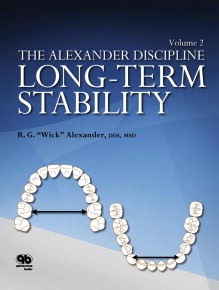Dr Alexander has been a major contributor to clinical orthodontics for many years. Also a longtime faculty member, he is currently a clinical professor of orthodontics at Baylor in Dallas, the University of Texas in Houston, and New York University.
As he explains in the introduction to Volume 2, “The purpose of this book is to recognize and identify guidelines that will place the teeth in particular positions that will produce the healthiest, most functional, most esthetic, and most stable results possible.”

The book is nicely laid out and very readable. Its organization is based on his “Six guidelines to building facial harmony and stability”: surrounding tissues, anterior torque control, skeletal control, occlusion, soft-tissue profile, and smile. In each chapter, he presents the evidence, mechanics, stability, and exceptions. I particularly liked the exceptions sections, because in them the author emphasizes that there are exceptions to all guidelines and rules. At the end of each chapter, case reports illustrate the clinical principles of the Alexander Discipline. The case reports are superb; it is the luxury of a text rather than a journal article that allows presentation of complete records before treatment, at the end of treatment, and many years after treatment and retention. The photographs are excellent and illustrate the appliances and mechanics used during treatment. The case reports were selected from the “Room of Truth,” the storage facility with the records of the 15,000 patients treated in Dr Alexander’s office.
The Alexander Discipline is a straightforward and logical approach to orthodontic treatment and follows, in general, what we know from the literature about the long-term stability of orthodontic treatment. However, he makes some statements that are not supported by current evidence: open bite causes mouth breathing, there is a strong relationship between temporomandibular disorders and occlusion, and there is a relationship between bruxism and occlusion. The appliances and archwires he advocates are logical, but there is no scientific evidence to support the statement that they result in better stability. Nevertheless, those minor issues do not detract significantly from the overall message of the book.
I see this as an excellent resource book rather than a reference text. It is worth sitting down and reading from cover to cover. I think that future treatment guidelines of the American Association of Orthodontists will not be much different from those of the Alexander Discipline.
Stay updated, free dental videos. Join our Telegram channel

VIDEdental - Online dental courses


